EIP-7045
Written by: Wisdom
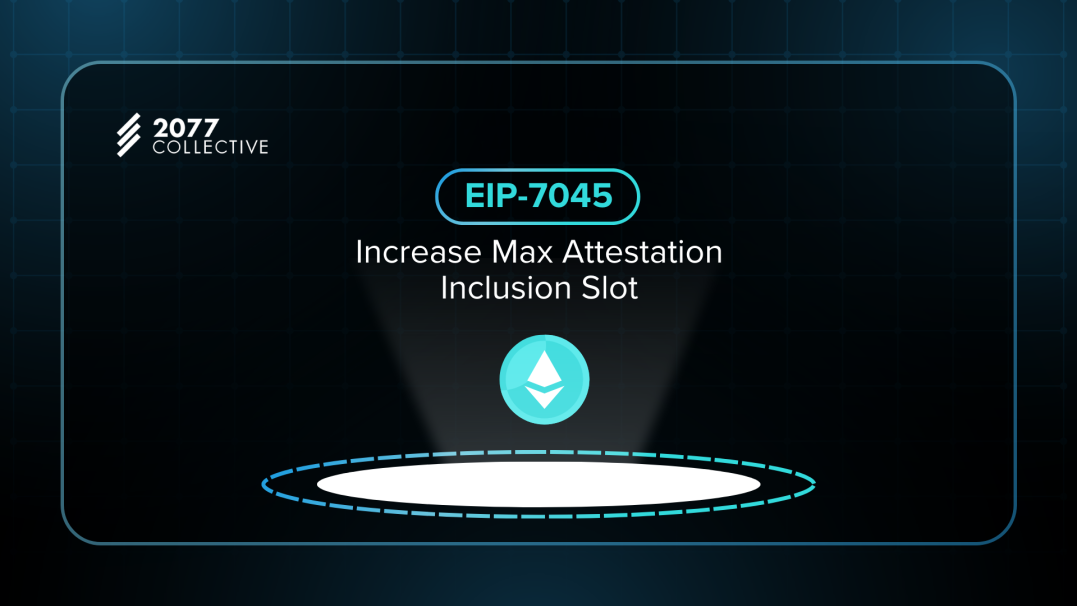
EIP-7045 is a proposal which increases the maximum inclusion slot for attestations from one rolling epoch to two non-rolling epochs. With this proposed change, validators have a longer period of time (up to 64 slots) to include attestations. By extending this time available for casting attestations for blocks, confirmation of blocks can be confirmed in a far more smooth and quicker manner given that attestations will be less likely to be discounted now compared to the previously more strict expiry conditions of the pre-EIP-7045 attestation inclusion window.
Introduction
In the Ethereum blockchain, the attestation process takes approximately 6.4 minutes and it is a crucial process that validators must take every epoch ( An epoch is a specific period of time on the blockchain ). Before going further, Attestation is a vote from a validator in the blockchain network, expressing their view on the current blockchain state.
During an epoch, validators propose an attestation to the network as this is done particularly to justify the legitimacy of the first and last block that was recently added in the current epoch.
Before getting into what exactly EIP-7045 does, let’s take a step back and understand various different topics surrounding this change namely Ethereum’s consensus layer, block trees, and the attestation inclusion window.
Ethereum Consensus Layer
The Ethereum consensus layer is made up primarily of two data structures which are:
-
Blocks
-
Attestations or Vote
During every block period on Ethereum (post-Merge upgrade to PoS), one validator is elected as a leader to propose a block and thereafter a set of validators are required to vote (through broadcast of an attestation) for what block they see as being the head of the blockchain in a given slot.
NOTE : The “circles” directed at the blocks are messages that validators voted on a given slot to pick who the head of the chain is and the subsequent circles shows that the votes are included in the next block. Blocks reference their parents so the arrow points backward as time moves from left to right as the block are subsequent blocks.
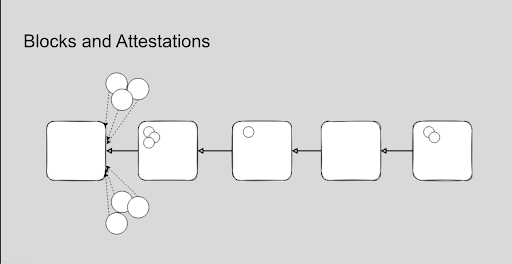
Block tree
Block trees are what makes up the blockchain. In block trees we can have conflicting proposals which means that for a given block we can have two potential descendants. Block trees are used to form the one single canonical history. So given a block tree ( as stated below), any of the green, blue and purple arrows pointing at the blocks- any could be the canonical blockchain depending on the view, algorithm, etc. Ethereum PoS uses the combination of two algorithm and they are:
-
Latest Message Driven - Greedy Heaviest Observed Sub Tree(LMD-GHOST): This deals with the tip of the chain
-
Friendly Finale Gathering ( FFG) : This deals with finalizing checkpoints forever in history
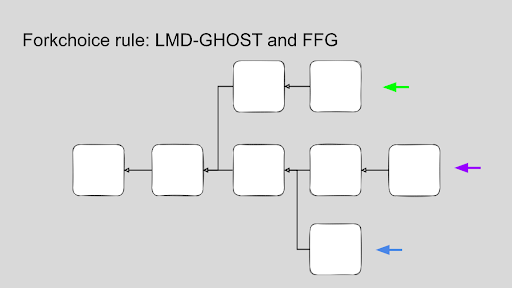
LMD-GHOST for forkchoice uses a simple algorithm that takes these attestations where each assigns weight recursively to the branch so that we sum up the attestation to give the tip which then becomes the canonical chain. LMD-GHOST can “re-org” as soon as we get new information which then changes the block, attestations and find a new tip that has a different weight which means any chain at the tip is subject to change.
This is where FFG comes in as it gives the opportunity to finalize checkpoints in a chain and once we finalize, it cannot be changed and any chain that is not included is the finality is no longer “ fair game “ and this does not give room for LMD-GHOST re-org.
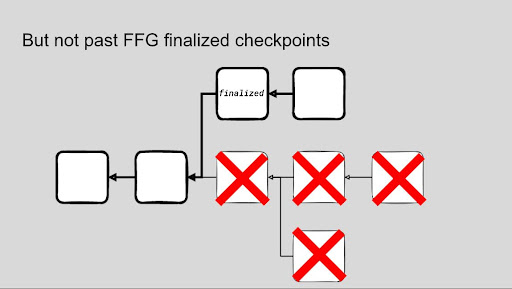
Attestation Inclusion Window
Attestations cannot be included forever as there is an inclusion window, So at slot N - this allows for attestation and from slot N + 1 to slot N + 32 - these attestation can be included as well can be included on chain. In most of the cases on mainnet, attestations are included in N + 1 but in very exceptional cases, these attestations can contain up to 32 slot( This is a large unit of work on the ethereum proof of stake chain ), This is a rolling attestation inclusion window and this what EIP-7045 does majorly by modifying the window.
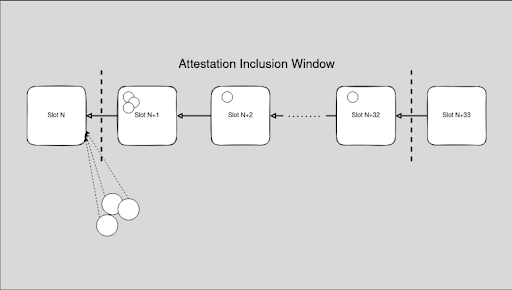
What is EIP-7045?
At its core, EIP-7045 was a proposal aimed at increasing the maximum attestation inclusion slot from attestation.slot + SLOTS_PER_EPOCH to the last epoch N + 1 where N is the epoch containing the attestation slot.
It’s worth noting that this increase is critical to the current LMD-GHOST security analysis and confirmation rule.
Let’s take a step back to find out the reason why the increase of attestation is such a big deal and this begs the question “ Why propose such EIP?”. The attestation process is of very high importance to the Ethereum community as it helps to maintain the integrity of the blockchain itself and helps in achieving consensus. Other importance of attestations include : Ensuring data authenticity, Ensuring consensus.
This proposal has no changes to the Execution Layer as it only affects the Consensus layer.
What makes an Attestation?
An attestation contains three parts :
-
aggreation_bits: This is a list of bits containing a single bit for each member of the committee. Each validator that participated in the aggregate signature is assigned a value of 1. They are ordered by the sort of the associated crosslink committee. -
Data : This contains : the slot number, committee number, beacon_block_root, source and target.
-
A signature : This is a BLS(Boneh-Lynn-Shacham) signature that aggregates the signatures of individual validators.
The Attestation data structure looks like this :
class Attestation(Container) : aggreation_bits : BItlist[MAX_VALIDATORS_PER_COMMITTEE] data : AttestationData signature : BLSSignatureAfter the building of data, the validator flips the aggregation_bits from 0 to 1 to show that they have participated, Finally the validator signs and broadcasts it to the network. To reduce the overhead associated with the broadcasting process within the network, all aggregations from individual validators are aggregated within a subnet before being broadcasted widely. A validator is selected as an aggregator - The aggregator is in charge of the collection of attestations it hears over the gossip network that has equivalent data to its own and broadcasts the attestation aggregate to a wider network. An aggregator is selected in each epoch.
Validators are rewarded for submitting attestations, with the attestation reward dependent on two variables: the base reward and the inclusion delay. The base reward is calculated based on the number of attesting validators and their effective staked ether balances, while the inclusion delay refers to the number of slots it takes for an attestation to be included in a block. THe validators have a maximum of one epoch to submit an attestation and if it were not to be submitted, It would be included in the next epoch with the aid of an inclusion delay.
Consensus Layer
The specifications changes for EIP-7045 was built into the Consensus Specs Deneb Upgrade. This change made two changes to the state transition function and they are :
-
Modify the
process_attestationto not have an upper on the slot check and instead define the inclusion range via the minimum slot as well as the target epoch being in either current or previous epoch. -
Modify
get_attestation_participation_flag_indicesto set the TIMELY_TARGET_FLAG without consideration of inclusion_delay to ensure that the extended inclusion attestations have a non-zero reward.
Furthermore, This specification modifies the attestation and aggregate attestations gossip conditions to allow for gossip during the extended stage.
Comparison between Pre EIP-7045 and Post EIP-7045
Pre EIP-7045 : It has a bound of +1 to +32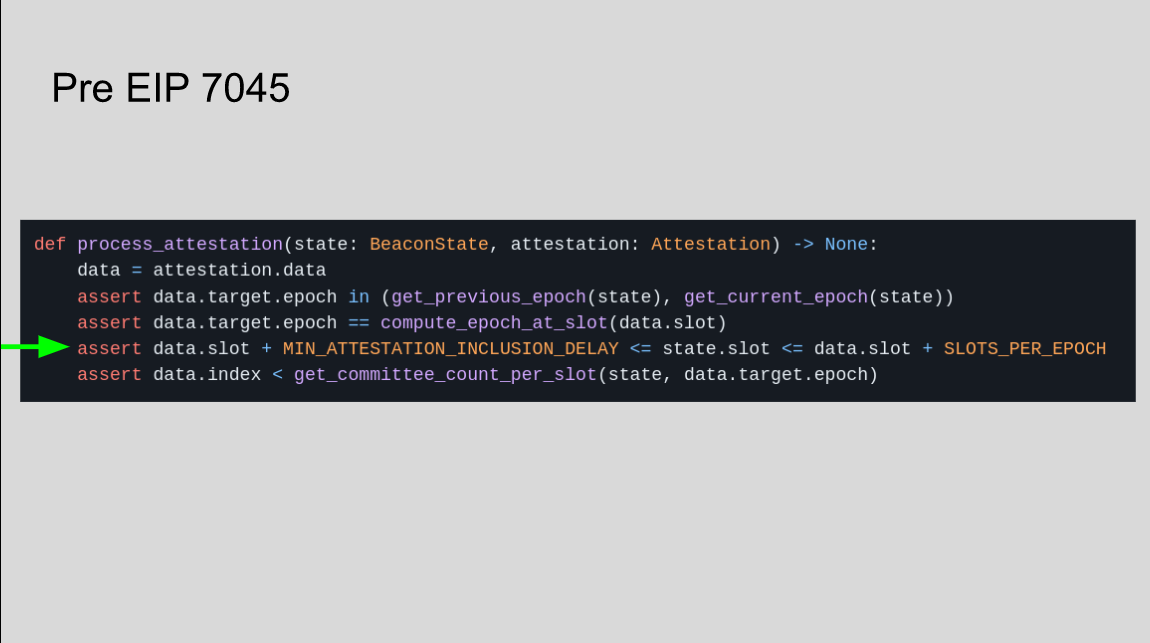
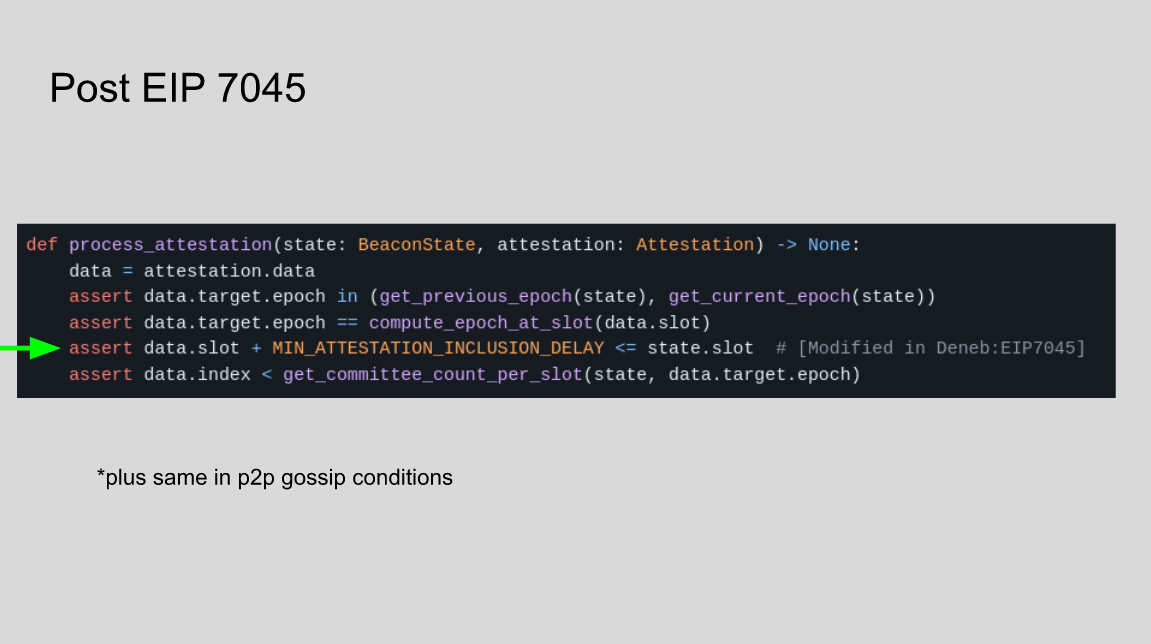
NOTE : This is a state transition function which there is a p2p gossip condition on what condition a node is allow to forward these messages to its peers
Removal of inclusion_delay consideration for target reward
Prior to the upgrade, The get_attestation_participation_flag_indices would only set the TIMELY_TARGET_FLAG
if the attestation was within a “SLOTS_PER_EPOCH. The inclusion_delay` was removed to ensure that whatever
the valid inclusion is for an attestation, it will receive a non-zero reward. This will ensure that the clients
will be eager to pack more attestations and this can be beneficial for security analysis.
Conclusion
In conclusion, EIP-7045 is a very important proposal as it aims to increase the max attestation inclusion slot on the Ethereum blockchain, helps to increase the data authenticity of the chain, establishes consensus and makes for an efficient network. While it has its own challenges, it makes it possible for the increased security of the LMD-GHOST and brings about faster confirmation rules which further bring about new and exciting opportunities for UX and gives applications different decision points.
Thanks for reading